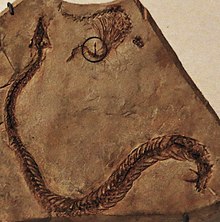Pachyrhachis
|
Pachyrhachis Temporal range: Late Cretaceous |
|
|---|---|
 |
|
| Fossil | |
| Scientific classification | |
| Kingdom: | Animalia |
| Phylum: | Chordata |
| Class: | Reptilia |
| Order: | Squamata |
| Suborder: | Serpentes |
| Family: | †Simoliophiidae |
| Genus: |
Pachyrhachis Haas, 1979 |
| Species: | P. problematicus |
| Binomial name | |
|
Pachyrhachis problematicus Haas, 1979 |
|
Pachyrhachis is an extinct genus of snake with well developed hind legs known from fossils discovered Ein Yabrud, near Ramallah, in the central West Bank. It is a relatively small snake, about 1 m (3–4 ft) long. Pachyrhachis appears to have been an ancient marine snake; the fossils occur in a marine limestone deposit, and the thickened bone of the ribs and vertebrae would have functioned as ballast to decrease the buoyancy of the animal, allowing it to dive beneath the ancient Cretaceous seas that it once inhabited.
Pachyrhachis is one of three genera of Cenomanian snakes with hindlimbs. Although many modern pythons and boas still retain remnants of legs, in the form of small spurs, the tiny legs of Pachyrhachis included a hip, knee, and ankle joint. Pachyrhachis was originally described by Haas (1979, 1980) who noted it had a puzzling melange of snake and lizard features; its status as an early snake was later confirmed (Caldwell and Lee 1997).
The position of Pachyrhachis within snakes has been debated (e.g. Lee and Scanlon 2002; Rieppel et al. 2003). Pachyrhachis is among the oldest known snakes and retains well-developed hind limbs, suggesting it represented a transitional form linking snakes to marine lizards (Lee and Scanlon 2002), though other studies place Pachyrhachis within the modern snake radiation Macrostomata (Zaher & Rieppel, 1999).
Other known fossil snakes with legs:
...
Wikipedia
